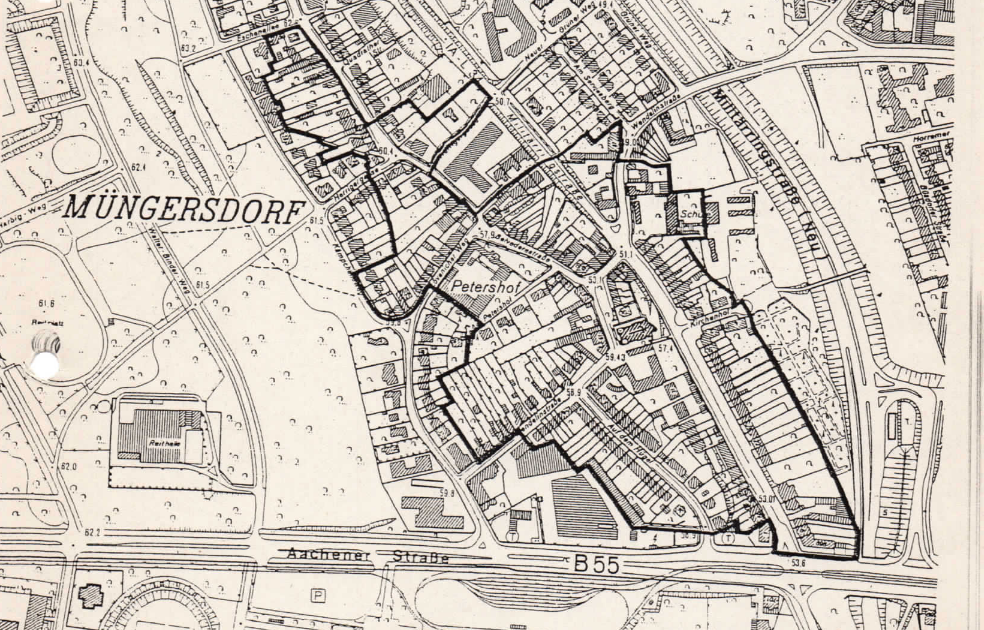The Petershof – Monument of the Month in June 2013
Two years before the Petershof finally closed its doors with the hasty closure of the daycare center in 2015 and was abandoned to decay, the Rheinischer Verein für Denkmalpflege und Landschaftsschutz (RDVL) had chosen the Petershof as “Monument of the Month” in June 2013. In the press release of the RDVL and in her lecture held in front of the Petershof on June 18, 2013, the art historian Anja Schmid-Engbrodt describes in detail the history of the Petershof and its architectural features (both texts unfortunately only available in German). She refers to the proposals of students of the master’s program in architecture at the University of Applied Sciences Cologne, who in 2011/2012, after a request of the Bürgerverein Müngersdorf e.V., had thought about a new use of the courtyard while preserving its original character. But despite these diverse efforts to preserve and use a monument, it was to take another six years before the City of Cologne commissioned the urban development office Luchterhandt from Hamburg to conduct a “Forging of Ideas” (Ideenschmiede) for the revitalization of the Petershof together with the residents of Müngersdorf. From the diverse ideas, Luchterhandt developed two concepts, one with a focus on “housing” and one with a focus on “work”. The housing concept is now the basis for the City of Cologne’s expression of interest procedure, in which proposals can be submitted until July 31, 2021.
(We thank Ms. Anja Schmid-Engbrodt for permission to publish the press release and the presentation manuscript on our website).
The preservation statute Müngersdorf from 1988 – still a guideline!
In the 1970s and 1980s, the great cleanup of Cologne’s urban landscape began. The last factories and industrial enterprises disappeared from districts such as Ehrenfeld, Kalk, Mülheim or Südstadt, and the last farms in the outer districts were closed down. A phase of wild conversion or new development began, with boring housing estates or grotesque high-rises that threatened to destroy old urban landscapes. In 1988, politicians pulled the ripcord for Müngersdorf with its unique old village center and issued a preservation statute (view document as PDF).

In a rarely unambiguous way, this statute names the real problem: “There is a conflict between the possible wishes of owners to increase the value of their properties in the preservation area by means of higher utilization or change of use and the associated changes to the building fabric, and the public interest in preserving the old townscape.” To give expression to this public interest, the preamble to the preservation statute highlights what is special about Müngersdorf: “The scope of the statute encompasses the ‘core area’ of the former village of Müngersdorf. The area has a large number of structures that characterize the townscape and urban form and are of urban planning, especially historical or artistic significance. The area is considered worthy of preservation because its distinctive form represents the characteristic townscape of Müngersdorf.” In conflicts about building projects, the citizens of Müngersdorf and in particular the Bürgerverein Müngersdorf e.V. have repeatedly referred to these statutes and have thus been able to prevent a whole series of planned building sins – see, for example, BlickPunkt Müngersdorf No. 14, Summer 2009: “Müngersdorf stellt sich quer” (Müngersdorf put its foot down).
The Petershof is located in the middle of the “core area” of this preservation statute and, with its old brick buildings and impressive trees, is characteristic for the image of this village. But a dead and decaying courtyard looks like a foreign body, like a sealed-off fortress. It can only be “preserved” in the sense of these statutes if it is filled with life again. That is what we are working on!
How the Petershof became a monument
We would have been happy to open the gates of Petershof for the nationwide Open Monument Day on September 12, 2021, and tell interested people about the history and possible future of this well-preserved courtyard. However, as long as the procedure for the allocation of the courtyard in hereditary building rights by the City of Cologne has not yet been completed, it will not allow any of the applicants to use the site in any way. Instead, this is the only way we can tell you a little bit about the former uses of the courtyard and its monument history.
During our research, we met Karin and Josef Hermanns in early August, who have a strong connection to the Petershof. They were pleased with our interest and willingly told us about their time on the court. Josef Hermanns ran the workshop of the Parks Department from 1968 to 2001, which had been housed there since 1949, and the family of four lived on the upper floor of the “White House” from 1971 to 1987. Some of the things we had noticed during our inspections with the real estate office now became more understandable and we learned their stories about many details. We have compiled them in a small photo reportage (unfortunately only available in German):
Petershof Köln-Müngersdorf – Die Hermanns – 1968-2002 (web quality, 2,4 MB)
Petershof Köln-Müngersdorf – Die Hermanns – 1968-2002 (print quality, 25 MB)
